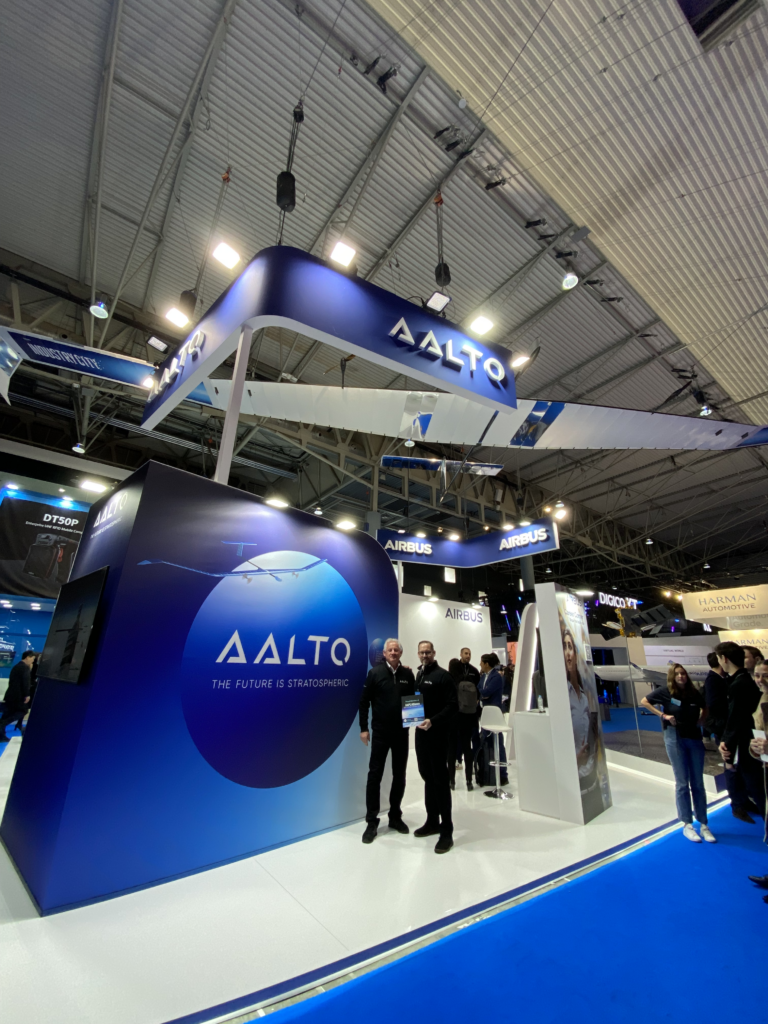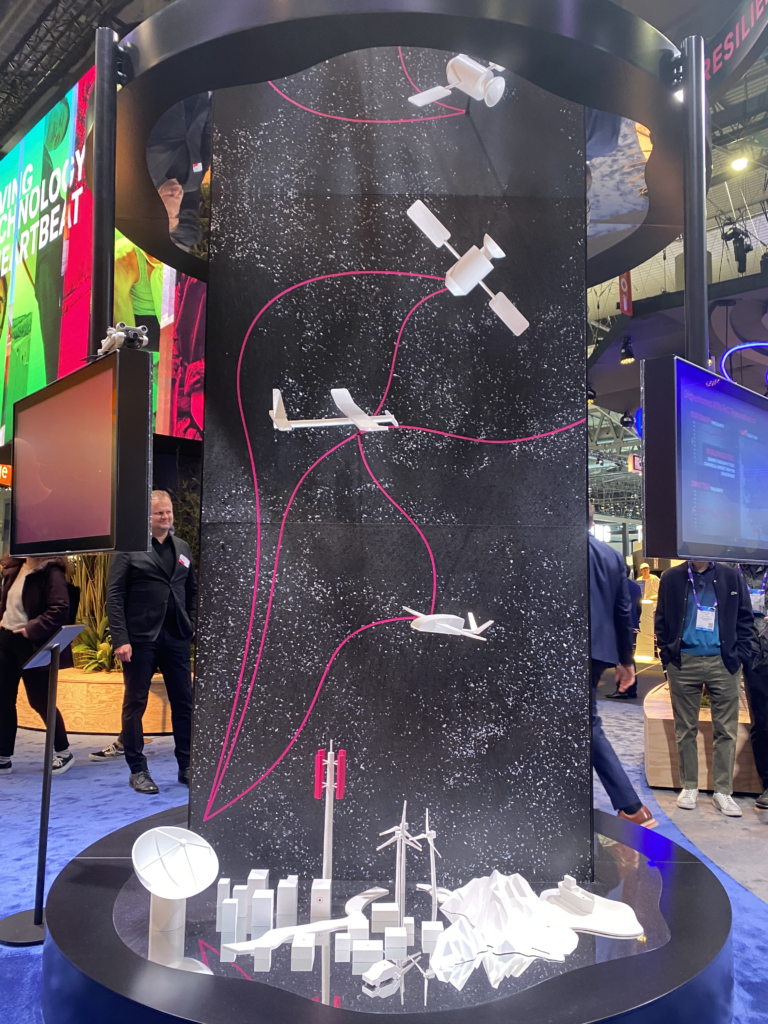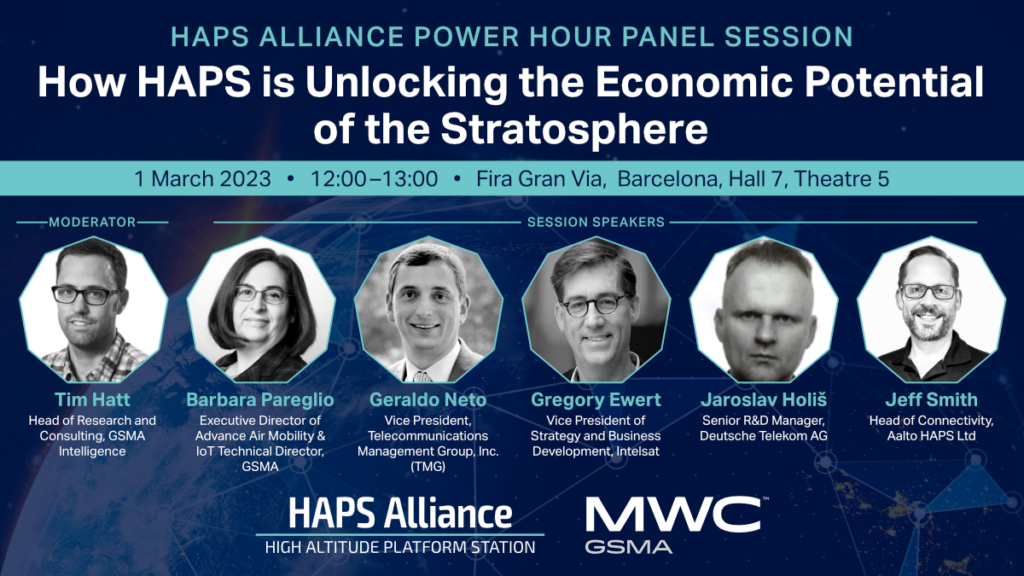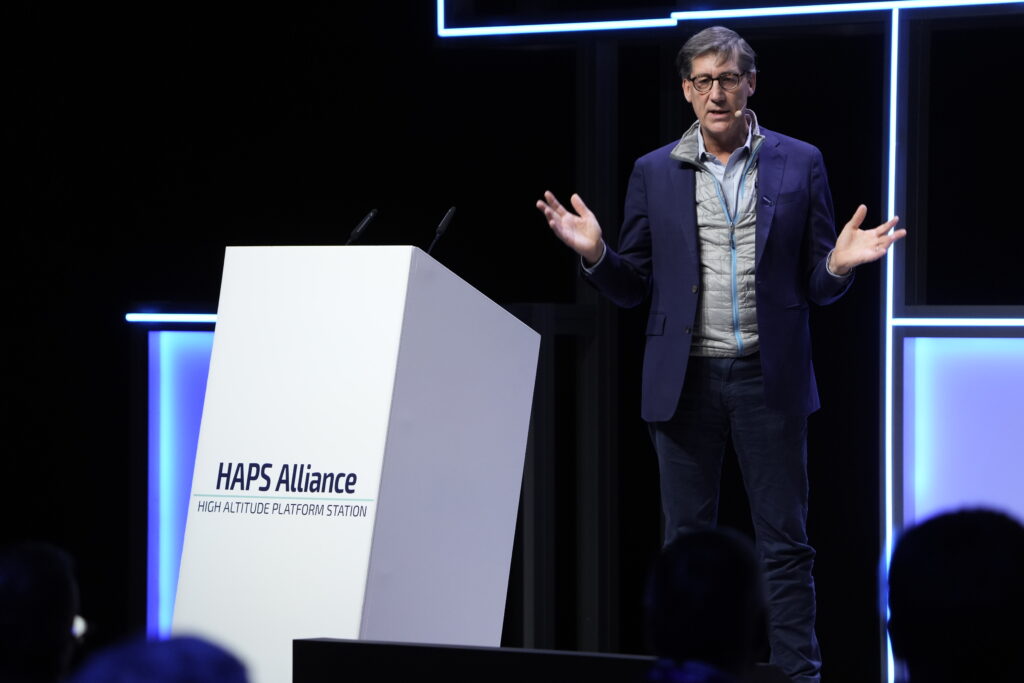
It’s one of the largest technology conferences in the world. From February 27 to March 2, over 88.5 thousand attendees and 2,400 exhibitors from 202 countries attended MWC Barcelona 2023. The conference dazzled attendees with displays of extended reality (XR) technology, enterprise 5G services and HAPS technology solutions.
To highlight innovation taking place in the stratosphere, the HAPS Alliance and its members put forward an impressively widespread presence.
Extensive HAPS Presence on the Show Floor

HAPS Alliance members exhibiting included Airbus, Capgemini, Deutsche Telekom, Ericsson, Intelsat, Nokia, NTT DOCOMO, Radical, Stratospheric Platforms Ltd, and Tonomus NEOM.

Over the Airbus and Aalto HAPS Ltd. booths hung a full-size Zephyr 7 HAPS aircraft, with mock-up displays of the Earth observation and connectivity payload capabilities. The display explained how HAPS solutions deliver world-leading, long-duration stratospheric flight and persistent services.
At the Deutsche Telekom booth, an interactive demo on how terrestrial and satellite-based solutions can be seamlessly integrated and the benefits of HAPS for disaster recovery was on display.
Capgemini presented a joint paper with Stratospheric Platforms Limited on the development of the Stratomast aircraft and the large, multibeam phased array antenna to deliver 5G cellular services from the stratosphere.
HAPS Alliance Power Hour Panel Discussion

Panel representatives from Aalto HAPS Ltd, Deutsche Telekom AG, GSMA, Intelsat, and TMG discussed the potential of HAPS solutions to cost-effectively connect the 2.9 billion unconnected people — almost half of humanity — around the globe. Held on Wednesday, March 1, the panel, “How HAPS is Unlocking the Economic Potential of the Stratosphere,” was attended by representatives from analyst firms, terrestrial broadcast network operators, telecom operators, satellite networks, and many others.
The goal of the talk was to introduce HAPS technology to new audiences, provide an overview of its many use cases, and talk about the compelling business case of HAPS for mobile network operators (MNOs).
Our panel expanded on these topics with authority and eloquence, and we couldn’t have asked for a better lineup. The panelists included:
- Barbara Pareglio, executive director of advance air mobility and IOT technical director, GSMA
- Geraldo Neto, VP of Telecommunications Management Group, Inc. (TMG)
- Gregory Ewert, VP of strategy and business development, Intelsat
- Jaroslav Holiš, senior R&D manager, Deutsche Telekom
- Jeff Smith, head of connectivity, AALTO HAPS Ltd
- Tim Hatt, head of research and consulting, GSMA Intelligence (moderator)

Takeaways from the panel discussion included:
- HAPS has earned more commercial interest in the last few years because it fills the connectivity gap between other technologies. When compared to both satellite and terrestrial, HAPS is more cost-effective and it opens up more revenue-generating use cases.
- Advances in power are making HAPS technology even more attractive. HAPS vehicle flights in the stratosphere are getting longer and longer thanks to longer battery life spans, augmented by solar power. In 2015, a HAPS plane was able to fly for fourteen consecutive days. In 2022, a flight hit the 64-day mark. This year, we believe we’ll be able to achieve a 100+ day flight, and in the years to come our goal is a 200+ day stratosphere flight.
- Hydrogen power is also an exciting option right now, and several HAPS platforms plan to run on hydrogen power. Effectively, hydrogen can provide almost unlimited power, and once that’s been achieved, the network coverage can become even stronger than the current 200Mbps. Right now, one HAPS vehicle can replace 450 terrestrial towers.
- HAPS deployments can tie into ESG goals including preserving wildlife habitat and reducing the CO₂ footprint of cellular connectivity, because terrestrial cell towers require roads, fiber optic connections, and cabled power that is often fossil-fuel based.
- HAPS can provide better service quality. We know that because HAPS are in the stratosphere, they can provide more complete ground coverage than a terrestrial tower. HAPS can also provide connectivity in densely populated areas where it may be expensive to put up a tower.
- HAPS is flexible. A connectivity payload approach can be technology-agnostic, and mobile network operators (MNOs) can stack LTE, 4G, 5G, Open RAN, and in the future 6G.
- Many countries can already use HAPS technology because it’s essentially another type of base station. If their regulatory frameworks are reasonably flexible, it may already be permissible under existing rules.
An engaged audience stimulated a lively Q&A session that continued after the session ended.
Watch the HAPS Alliance MWC Panel and Discussion on YouTube
More resources:
